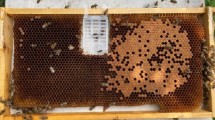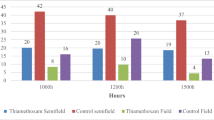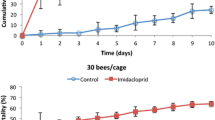Abstract
Bee colonies were dosed with tylosin tartrate 1.1 g per hive (single dose in sucrose solution) and samples of honey were then collected at intervals over a 20-week period. The samples were analysed for tylosin A and desmycosin (tylosin B) using LC-MS/MS. The mean concentration of tylosin A in the honey (pooled results) 3 days after dosing was 17 μg/g, declining to 0.9 μg/g after 140 days. The mean concentration of desmycosin was 2.3 μg/g, 3 days after dosing declining to 1.1 μg/g after 140 days. The shook swarm procedure was investigated and resulted in a tylosin A concentration in brood honey of 10 μg/g, 3 days after dosing declining to 0.02 μg/g, 140 days after dosing. A corresponding decrease in the mean concentrations of desmycosin in brood honey, 1.1 fxg/g, 3 days after dosing to 0.03 [μg/g, 140 days after dosing also was observed. Tylosin A depletes to desmycosin in honey and can still be detected 238 days after dosing. Thus a more accurate residue definition is the sum of tylosin A and desmycosin.
Zusammenfassung
Tylosin wurde kürzlich in den USA für die Bekämpfung der Amerikanischen Faulbrut in Bienenvölkern zugelassen und stellt somit ein alternatives Antibiotikum zu Oxytetracyclin dar. Allerdings sind nach EU-Bestimmungen Tylosinrückstände in Honig nicht erlaubt und Honige aus den USA mit Tylosinrückständen wären auf dem EU-Markt nicht verkehrsfähig. Daher wurde hier die Beziehung zwischen Tylosin A und dem Abbauprodukt Desmykosin untersucht. Damit sollte eine Markersubstanz etabliert werden, um den Abbau von Tylosin im Bienenvolk zu erfassen und die Verwendung dieses Wirkstoffes in der Imkerei nachzuweisen.
Bienenvölkern wurde eine Dosis von 1,1g Tylosintartrat pro Volk in Form einer einmaligen Zuckerlösung gegeben. Die Proben wurden vor der Futtergabe und danach über 20 Wochen in regelmäßigen Abständen und schließlich nach der Überwinterung gezogen. Die Proben wurden über HPLC-MS auf Tylosin A und Desmycosin analysiert.
Die Konzentration an Tylosin A im Honig nahm im Zeitraum der Probennahmen kontinuierlich ab: Von 17 [μg/g 3 Tage nach Applikation über 3,3 μg/kg 56 Tage danach bis auf 0,9 μg/kg 140 Tage danach. Die Konzentration von Desmycosin nahm lediglich von 2,3 μg/kg 3 Tage nach Applikation auf 1,1 μg/kg 140 Tage danach ab (Abb. 1, Tab. III und IV). Es gibt einen raschen Abbau an Tylosin A während der ersten 28 Tage nach Applikation gefolgt von einer geringeren Abbaurate danach. Trotz der Abnahme an Tylosin bleibt die Konzentration an Desmycosin weitgehend konstant, vermutlich wegen einer kontinuierlichen Umwandlung von Tylosin A zu Desmycosin. Die Konzentrationen von Desmycosin und Tylosin A gleichen sich 84 Tage nach der Applikation an (Abb. 2).
Die Kunstschwarmbildung auf neues Wabenwerk 7 Tage nach der Applikation reduzierte die Rückstandskonzentrationen von Tylosin A und Desmycosin um den Faktor 30 zum Ende der Probennahme (140 Tage nach Applikation). Tab. V zeigt vergleichend die Abnahme der Rückstandskonzentrationen für behandelte Bienenvölker mit und ohne Kunstschwarmbildung. Nach Applikation von Tylosin können Rückstände auch 238 Tage danach noch nachgewiesen werden selbst wenn zwischenzeitlich die Kunstschwarmmethode angewendet wird. Tylosin A ist eine geeignete Markersubstanz um den Gebrauch bzw. Missbrauch von Tylosin nachzuweisen. Eine exakte Bestimmung von Tylosinrückständen sollte allerdings über die Summe von Tylosin A und Desmycosin erfolgen.
Similar content being viewed by others
References
Caldow M., Stead S.L., Day J., Sharman M., Situ C., Elliot C. (2005) Development and Validation of an Optical SPR Biosensor Assay for Tylosin Residues in Honey, J. Agric. Food Chem. 53, 7367–7370.
CFIA (2003–2004 survey) Report On Pesticides, Agricultural Chemicals, Veterinary Drugs, Environmental Pollutants and Other Impurities in Agri-Food Commodities of Animal Origin, Compliance Summary For Honey (5-Year Progression of Chemical Residues), [online] http://www.inspection.gc.ca/english/fssa/microchem/resid/2003-2004/anima_hme.shtml (accessed 5 March 2007).
CFIA (2005), working residue limit for tylosin in Honey, [online] http://hc-sc.gc.ca/dhp-mps/legislation/vet/pol/cfia-acia_amr-ram_table_e.html (accessed 5 March 2007).
EMEA, Committee for Veterinary Medicine Products (1997) Tylosin (3), Summary Report, [online] http://www.emea.europa.eu/pdfs/vet/mrls/020597en.pdf (accessed on 5 March 2007).
FDA Supplemental New Animal Drug Application (2005) NADA 013-076, Tylan (tylosin tartrate) soluble, [online] http:www.fda.gov/cvm/FOI/013-076sl01705.pdf (accessed on 5 March 2007).
Feldlaufer M.F, Pettis J.S., Kochansky J.P, Kramer M. (2004) Residue Levels in Honey after Colony Treatment with the Antibiotic Tylosin, Am. Bee J. 144, 143–145.
Kochansky J. (2004) Degradation of tylosin residues in honey, J. Apic. Res. 43, 65–68.
Kochansky J., Knox D., Shimanuki H. (1999) Comparative stability of oxytetracycline and tylosin in sugar syrup, Apidologie 30, 321–326.
Kochansky J., Knox D.A., Feldlaufer M., Pettis S. (2001) Screening alternative antibiotics against oxytetracycline-susceptible and resistant Paenibacillus larvae, Apidologie 32, 215–222.
Thompson H.M., Waite R.J., Wilkins S., Brown M.A., Bigwood T., Shaw M., Ridgway C., Sharman M. (2006) Effects of shook swarm and supplementary feeding on oxytetracycline levels in honey extracted from treated colonies, Apidologie 37, 51–57.
Veterinary Residues Committee (2004) Annual Report, [online] http://www.vet-residues-committee.gov.uk/reports/ar2004.htm (accessed on 5 March 2007).
Wang J. (2004) Determination of Five Macrolide Antibiotic Residues in Honey by LC-ESI-MS and LC-ESI-MS/MS, J. Agric. Food Chem. 52, 171–181.
Author information
Authors and Affiliations
Corresponding author
Additional information
Manuscript editor: Jean-Noël Tasei
British Crown Copyright 2007
Rights and permissions
About this article
Cite this article
Adams, S.J., Heinrich, K., Hetmanski, M. et al. Study of the depletion of tylosin residues in honey extracted from treated honeybee (Apis mellifera) colonies and the effect of the shook swarm procedure. Apidologie 38, 315–322 (2007). https://doi.org/10.1051/apido:2007017
Received:
Revised:
Accepted:
Issue Date:
DOI: https://doi.org/10.1051/apido:2007017




